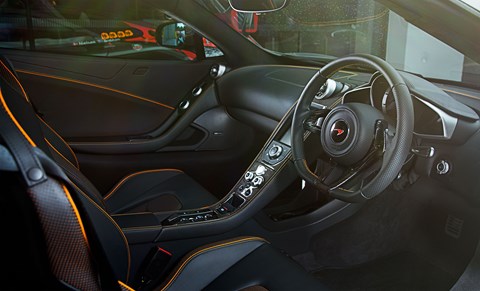► Month seven with the McLaren 650S
► It’s time to say goodbye to the McLaren
► Bike-like characteristics will be sorely missed
First McLaren, first convertible, first supercar. First time I had 641bhp on tap day-in, day-out. First time I’ve done 8.6mpg (Silverstone), 185mph (Silverstone) and my journey home in less than 20 minutes (not Silverstone). First time I’ve picked up the keys to anything in a place with orange ticks on the official stationary, Senna pictures on the walls and P1s ‘out back in the workshop’. First 650S Spider. Last 650S Spider. Balls.
Forgive me if you’ve never ridden a motorcycle, and particularly if you have no time for them, but the parallels between using this country’s road network on a bike and doing so in the 650S Spider were striking. It starts with the nest of nerves that erupts in your tummy when you start the thing.
Eighteen years since I passed my test and after perhaps 120,000 miles on all kinds of bikes in all kinds of conditions, firing one up still gives me the heebie-jeebies. (As well it should: few things in life are so unfailingly unforgiving).
The McLaren was the same. You can bound out of the house without a a care in the world, lift that door and drop into that perfectly sculpted seat thinking of everything and nothing all at once, of Scarlett Johansson, deadlines and towering pulled pork sandwiches. But the moment you push the starter that engine snaps you into the right here, right now. As well it should.
Then there’s the way in which the McLaren can so effortlessly bypass everything else on the road, as a motorcycle can. Your crushing performance advantage is to be used sparingly of course, but it is at once faintly scary and hugely relaxing. There’s never any need to feverishly plot safe overtakes based on a scant opportunity and a good run up, or to fall into lowest-common-denominator line behind that Honda Jazz.
It takes time to acclimatise to the astonishing rates at which the McLaren can gain and lose speed, but to do so, and to reach the state in which you’re serenely slipping past everything else on the road so smoothly and courteously that it doesn’t even notice your passing, is to achieve a kind of nirvana. That you can do all of this without a roof, and invite in the world in all its multi-sensory glory, just ramps things up a notch: the smell before rain as you race home in the first drops of a summer evening downpour; the welcome chill as an August day finally cedes its heat with dusk.
So all was bliss? Largely yes, as you might expect of a car costing more than £200,000 (and nearer £250k optioned as ours was). Reliability was absolute. You might think that a given on such rarified machinery but it really isn’t. Comfort and practicality (and therefore versatility) – McLaren’s claimed USPs in this odd little corner of cardom – are impressive.
Where Lamborghini persists with seats that are agony to sit on and Ferrari with a firm emphasis on breathless stimulation and chaotic interior design, the McLaren is calm, comfortable and hugely capable. Turn things up and down via the Handling and Powertrain controls and the car responds emphatically, shifting from plush, quiet mile-eater (with exemplary ergonomics and great forward visibility) to hair-trigger circuit-basher.
That control system is too fussy – Ferrari and Porsche do it better with a rotary control on the wheel – and I still think the traction-control leash would be more intuitively governed by the Powertrain rather than the Handling control (I learnt the interesting way, with a generous kick sideways attempting a pass in the rain) but generally the McLaren’s interfaces are simple and effective. (The 675LT separates the anti-crash electronics from Handling, so you can enjoy the firmer dampers and weightier steering of Sport with the safety net in place).
Certainly I grew to love the luxuriously sparse cockpit: never has so little been so welcome and so nicely executed. Those cast aluminium levers! The gorgeous click of the one-piece paddleshifter! The rock-solid, LMP1-esque art of the throttle and brake pedals! I grew to love our car’s relatively understated external appearance too but it’s hard to argue that, at £11,200, orange brake calipers, a smattering of carbonfibre and Storm Grey special paint are essential. Had it been my car I’d have stripped things right back and plumped only for the Sports exhaust (terrifying under bridges at full chat) at £4790, the electric and heated memory seats (£2730) and the parking sensors (£1640).
The 650S is now the oldest model in the range, though given how rapidly McLaren is renewing and expanding its line-up, that’s not saying much. Certainly the 675LT and 570S have put the 650S under pressure, the former by ramping everything up a few notches to deliver a more potent hit, and the latter by undercutting the 650 on which it’s based for very little discernible loss of brilliance.
But that doesn’t in any way diminish the appeal of the 650S Spider, a car so relentlessly capable and seductively impressive that within a few hundred miles you do wonder how you’re ever going to get by without one. But go without one I must. Still, better to have loved and lost.

Count the cost
Cost new: £251,080 (including £35,560 of options)
Dealer sale price: £208,500
Private sale price: £202,995
Part-exchange price: £199,450
Cost per mile: 29p
Cost per mile including depreciation: £15.85
Logbook: McLaren 650S Spider
Engine: 3799cc twin-turbo V8, 641bhp @ 7250rpm, 500lb ft @ 6000rpm
Transmission: 7-speed auto with paddleshift, rear-wheel drive
Stats: 3.0sec 0-62mph, 204mph
Price: £215,520
As tested: £251,080
Miles this month: 714.7
Total miles: 3317.7
Our mpg: 15.9
Official mpg: 24.1
Fuel cost overall: £955.01
Extra costs: £0
Read more from the May 2016 issue of CAR magazine